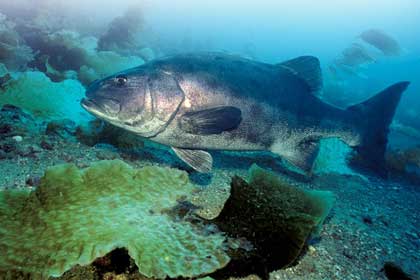My first giant sea bass encounter occurred off San Nicolas Island in the 1970s. I sensed something overhead and looked up. A gigantic Goodyear blimp hovered over me.
A cartoon I‘d seen recently popped into my head. Two large fish were face to face. A scuba diver’s legs and fin-clad feet protruded from the puckered mouth of one wearing a sour expression. The other fish was saying, “I told you to peel them first.”
I was a new diver and didn’t know if giant sea bass ate people or not. This one had a mouth big enough to swallow people. I tried to look like part of the bottom.
The fish didn’t seem aggressive, just curious. Still, my lobster-hunting buddy was nearly out of sight. I quickly abandoned my effort to try to look inedible and hurriedly rejoined him.
When I got the nerve to look up again the fish was gone. Twenty years would pass before I saw another one in the wild.
That second encounter was at Catalina’s Italian Gardens on September 29, 2000. Divers had been seeing and photographing giant sea bass there for several months. They kept the site a secret at first but it’s hard to keep a big fish secret like that for long.
A charter boat was just leaving as we arrived so we had Italian Gardens all to ourselves. The sun was out, the ocean was absolutely flat and the visibility was at least 50 feet.
The first dive surpassed all expectations. Five amazingly mellow giant sea bass allowed us close enough to touch them. Of course, none of us did because we didn’t want to spook those magnificent creatures and cause them to flee.
We photographed the fish as they hung motionless just above the bottom in 50 to 70 feet of water, being cleaned by señoritas and juvenile kelp bass. The large, placid fish reminded me of dairy cows. I remembered my first encounter and chuckled.
Giant sea bass were once incredibly abundant. They were also easy to find and catch (or spear) because they spawn at the same time and in the same areas every year. Within a very short period of time after the fisheries appeared the giant sea bass population plummeted. By 1932, so few were being landed in the U.S. that commercial fisherman had to go to Mexico, although the population there had also been seriously impacted as well. By the late 1970s the fishery was nearly nonexistent.
In 1981, the California legislature banned both the commercial and recreational fishing of giant sea bass with certain exceptions. Seven years later, an amendment made the ban even more restrictive. In 1994, Proposition 132 was implemented. It banned the use of gill and trammel nets, three-layered nets designed to entangle fishes and crustaceans, within three miles of the Southern California coast. Proposition 132 appears to have significantly reduced the incidental catch of giant sea bass. The recent implementation of Marine Life Protected Areas (MLPAs) in locales where giant sea bass spawn is expected to eliminate the deaths of fish that are accidentally caught and then released.
The population is still very low. Giant sea bass are listed as critically endangered by the International Union for Conservation of Nature. But there is encouraging news, as giant sea bass appear to be making a comeback. During spawning season now, small schools of giant sea bass can be found off all eight Channel Islands and along the SoCal coast. Yet, as big as they are, no one knows where these fish spend the rest of the year.
During spawning, giant sea bass release eggs and sperm into the water column. The fertilized eggs float to the surface. When the larvae hatch 36 hours later, the hatchlings feed on plankton for approximately one month before settling down to the sea floor where the morph into what we think of as fish, though not ones that look like their parents. The bodies of the juveniles have a truncated rockfish-like shape and are red or orange with black and white spots. The body elongates with age.
Giant sea bass are slow growing. It can take six years for a fish to reach 30 pounds; ten years to reach 100 pounds; and up to fifteen years to reach 150 pounds.
The preferred prey of giant sea bass consists of a variety of fishes, including stingrays and small sharks, as well as crabs, spiny lobster and mantis shrimp.










